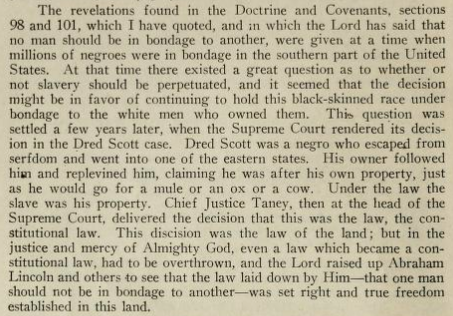Charles Nibley celebrates emancipation of slavery and overthrow of part of Constitution.
- Type
- Speech / Court Transcript
- Source
- Charles Nibley LDS
- Hearsay
- Direct
- Reference
Charles Nibley, Conference Report (April 1925): 26
- Scribe/Publisher
- Conference Report
- People
- Charles Nibley
- Audience
- Reading Public
- Transcription
The revelations found in the Doctrine and Covenants, sections 98 and 101, which I have quoted, and in which the Lord has said that no man should be in bondage to another, were given at a time when millions of negroes were in bondage in the southern part of the United States. At that time there existed a great question as to whether or not slavery should be perpetuated, and it seemed that the decision might be in favor of continuing to hold this black-skinned race under bondage to the white men who owned them. The question was settled a few years later, when the Supreme Court rendered its decision in the Dred Scott case. Dred Scott was a negro who escaped from serfdom and went into one of the eastern states. His owner followed him and retrieved him, claiming he was after his own property, just as he would go for a mule or an ox or a cow. Under the law the slave was his property. Chief Justice Taney, then at the head of the Supreme Court, delivered the decision that this was the law, the constitutional law. This decision was the law of the land; but in the justice and mercy of Almighty God, even a law which became a constitutional law, had to be overthrown, and the Lord raised up Abraham Lincoln and others -to see that the law laid down by Him — that one man should not be in bondage to another — was set right and true freedom established in this land.
The B. H. Roberts Foundation is not owned by, operated by, or affiliated with the Church of Jesus Christ of Latter-day Saints.

